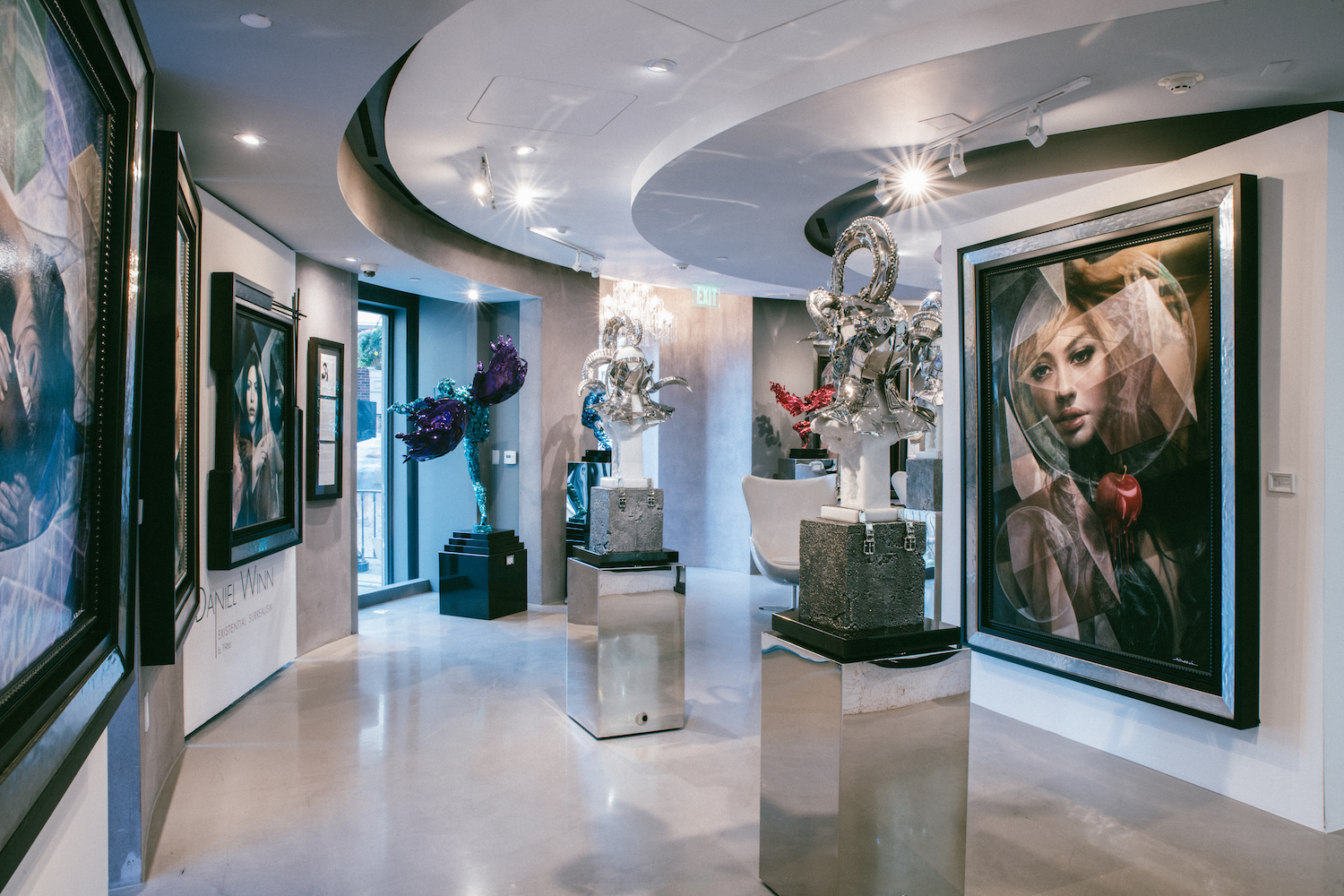Randall J. Slavin knows a thing or two about fine art. The entrepreneur and art dealer exploded onto the art scene back in 1997, launching his own company Masterpiece Publishing with one goal: to connect esteemed collectors with quality artwork while protecting the reputation of the artists.
Insert Winn Slavin Fine Art, the renowned art gallery that has locations from Beverly Hills to Shanghai. Situated on beautiful Rodeo Drive, the gallery just celebrated its second year at the renowned location serving as a premiere provider of fine art with a focus on integrity, service, and innovation.
Winn Slavin represents such contemporary artists as Vietnamese-American artist Sir Daniel K. Winn, American sculptor Ira Reines, American painter Jamie Pettis, Serbian sculptor Boban, and Colombian artist Carlos Torres. Beyond the U.S., Winn Slavin boasts presence in both Shanghai and Vietnam, actively sponsoring museum and gallery exhibitions around the world.
Sheen spoke with Randall J. Slavin on his entrepreneurship, how he selects artists, fostering relationships with art collectors, and more!

How did you get your start in the art dealing world?
My father was an artist, but one who never made a living at it. I had no intention of making fine art my career. My degrees are in business and information systems. I entered the gallery world in 1995 when I met Sir Daniel Winn. He had a small gallery in Laguna Beach, California and needed help with the business side of things. It evolved from there.
Can you share a bit more about the business side of the art world?
The art business is much like any other business with all the usual challenges. However, there are also issues unique to the art world, or at least unique to the world of creative endeavors. There’s a marked contrast between the intuitive mind of a creative artist and the rational mind of a business person. Success in the gallery business requires the ability to mediate that contrast.
Can you share with us more about starting and growing Winn Slavin Fine Art?
Winn Slavin Fine Art grew out of my endeavors as an artist agent and wholesaler. The parent company, Masterpiece Publishing, Inc., started in 1995 and sold to over a hundred galleries prior to the Great Recession. The recession, the advent of inexpensive reproduction techniques, and the rise of social media fundamentally changed the art publishing business. We went upmarket and became a strategic partner to a dozen or so galleries for a number of years before deciding that no one could represent our artists better than we could. In 2016, we entered the retail gallery market as Winn Slavin Fine Art.
How do you select the artists you represent at Winn Slavin Fine Art?
Curating a gallery collection is a combination of both rational and intuitive evaluations. An artist needs to have a distinctive style — something that is recognizable before even seeing the artist’s name. They also need to be prolific enough to produce enough work that we can meet demand, but not so prolific that they flood the market. Finally, an artist needs to be emotionally prepared for success. They have to have the self-esteem to know that their work is good, but the humility to recognize that they cannot succeed on their own.
How do your galleries in Beverly Hills, Shanghai, and Vietnam differ from one another? Do the collectors in those regions affect the art selected at each location?
There are both similarities and differences. In all locations, we are selling to the highest income earners. However, each market has a different level of sophistication in terms of understanding art and collecting it. There are also cultural sensitivities that need to be understood and observed. China has strict censorship rules regarding artwork that is brought into the country — every artwork imported has to be approved by government censors. Vietnam is the least developed market, but there is a strong interest among the well-to-do to engage with fine art, which should lead to rapid growth of the market. The U.S. is the most liberal in terms of subject matter and has a relatively sophisticated clientele, but it’s also one of the most competitive markets as the U.S. averages 40% of annual global art sales.
What goes into fostering relationships with collectors?
Collectors, especially at the level we sell to, are often looking for an experience as much as they are looking for a product. Art collecting opens a new world for many collectors. They come to understand the role that art can play in their emotional and spiritual lives beyond simply the aesthetic role.
What goes into establishing a successful gallery?
Blood, sweat and tears! The gallery business is very hard work. Outsiders often see it only as parties with champagne and caviar on yachts and private jets. That’s a part of the business, but there are a lot of long hours, difficulties to overcome, and smart decision making required for a gallery to be successful.
How does Winn Slavin protect the reputation of its artists and value of the art?
Fine art isn’t a commodity. Even the most prolific artist can only produce a certain amount of art within their lifetime, at least if they do it with integrity. The key to enhancing the value of an artist’s work is balancing supply and demand. Prices go up if demand outstrips supply, but to maintain that value, they can’t go down if demand waivers. Conversely, if demand exceeds supply by too much, collectors will lose interest and look to other artists. It’s a balancing act.
What exhibitions have you sponsored? Anything upcoming?
Since 1995, we’ve participated in hundreds of exhibitions for our artists — museum exhibitions, art fairs, and gallery exhibitions. At the Beverly Hills galleries, we do around a half dozen formal, red-carpet exhibitions each year for our artists. We’re currently featuring a dual artist exhibition at our Santa Monica Boulevard gallery of James Peter Henry and Salvador Dali which explores the connections between Surrealism and Aboriginalism. The next event at our Rodeo Drive location is a collector invitation-only split-venue exhibition which includes a screening of Sir Daniel Winn’s short film “Creation” and the debut of his Light Matter series. The gallery exhibition will open to the public on Sunday, March 19th.
Is there a particular style of art Winn Slavin mostly offers?
Our curation criteria are more driven by innovation, integrity, and quality than a particular style. However, we do tend towards representational art and figurative art in particular. We’re also very focused on sculpture, offering the finest bronze, Lucite, glass and mixed media contemporary sculptures available.
Can you tell us more about the artists Winn Slavin represents?
The majority of the artists we represent are contemporary, living artists. We do offer Modern Masters as well, but our focus really is Contemporary Masters. Vietnamese-American Sir Daniel Winn is one of the artists that we represent exclusively, both as a gallery and as an agency. He is a master painter and sculptor doing primarily figurative work. Ira Reines is an American master sculptor that we’ve represented for nearly two decades. He does beautiful figurative sculptor in a classical style, but with a contemporary inspiration. We’re always developing new artists. Perhaps the most promising are Australian-American James Peter Henry, whose work draws on Aboriginal influences, and California-native CANTSTOPGOODBOY, whose work is vibrant Pop Art.
Who mainly makes up your clientele?
Our clients are typically individuals who have achieved a level of prominence in their professions and are looking to expand their experience of life. Often they are new collectors who develop a deep passion for art and the role it can play in their daily lives.
Price ranges of pieces sold at Winn Slavin?
Our prices vary significantly based on the reputations of the artists and the attributes of the artwork. Our average price point is around $35,000, but our prices range from just under $5,000 up to $3.5 million.







Add Comment